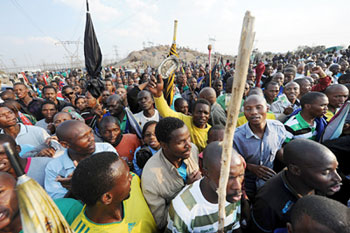

Vol. 76/No. 33 September 10, 2012

|
| AFP/Getty Images |
| Aug. 23 memorial service in Marikana, South Africa, for striking platinum miners mowed down in a hail of police bullets Aug. 16. Miners are demanding higher wages and job safety. |
“We are going to protest until we get what we want.” one miner told the Mail & Guardian Aug. 20. The strike began Aug. 10.
The massacre shocked people across the country and the world. Video of the cop assault was widely posted on media and other websites internationally.
Claiming that the miners were threatening them with spears, machetes, clubs and a handful of firearms, the cops opened fire with automatic weapons Aug. 16. The hail of gunfire aimed at the miners was so thick it kicked up clouds of yellow dust.
Police Chief Riah Phiyega told a press conference the next day that the police “were forced to utilize maximum force to defend themselves.” The cops arrested 259 workers following the clash, who face charges ranging from public violence and malicious damage to property to armed robbery and murder.
For 18 years the African National Congress, which led the liberation fight that dismantled apartheid, has been in power. While the police are now majority black, like the rest of the government, and there is a new layer of black capitalists and black middle class layers, economic disparities for the country’s black majority have worsened. Some 8.7 million of South Africa’s 50 million people earn $1.25 a day or less.
Led by the Association of Mineworkers and Construction Union, the rock drillers are demanding a 300 percent increase in the base wage from 4,000 rand ($480) a month to 12,500 ($1,500), safer working conditions, and overtime pay.
Rock drilling, a dangerous job
The rock drillers, mostly from the Eastern Cape and Lesotho, are among the lowest paid in the mine, which has some 28,000 workers, and do some of the hardest, most dangerous work. Because they have many different native languages, the miners often communicate in a dialect they have devised—Fanagalo, a mix of Zulu, Xhosa, English and Afrikaans.According to an August report by the Bench Marks Foundation, the number of “fatal accidents” at the Lonmin mines has doubled since January 2011.
There had been no electricity for a month in a section of company housing when the Bench Marks delegation visited. Many workers live in nearby shantytowns to get a company “living-out allowance” and avoid staying in overcrowded company hostels.
Prior to the strike “workers had bypassed the set of procedures that the companies and unions have agreed to and went straight to management,” Emma Crawshaw, Lonmin spokeswoman said from London Aug. 24. “There are talks going on now to get the miners back to work, but these are not wage negotiations.”
Crawshaw claimed the Association of Mineworkers and Construction Union was “trying to win new members by promising high wages and through intimidation and violence.” Eight workers and two policemen died prior to the massacre.
The National Union of Mineworkers, which organizes about 50 percent of the workers at the Lonmin mine, is looked at with suspicion by many of the strikers, who view it as too close to management and the government.
An Aug. 16 statement by the National Union of Mineworkers condemned the strike and called on miners to go back to work and for the cops to “ensure successful prosecution of those arrested.”
The South African Communist Party, which has ministers in the government, also attacked the striking workers, calling on the police “to act swiftly and bring to book these hooligans who have substituted reason and dialogue for bullets.” It also demanded that the government investigate the “pseudo-trade union AMCU” and arrest its central leaders.
Unionists debate role of the cops
“COSATU condemns both sides in Marikana,” Solly Phetoe, northwest provincial secretary of the Congress of South African Trade Unions, told the Militant by phone.“We recognize that we need to close the wage gap,” he said. “But the police needed to be there to find a solution to cool down the workers, but not to shoot.”
Some COSATU unions have a different view.
“The killing of 37 workers, regardless of which Union they belong to, or their demands, or the way that they have conducted their dispute is still a shocking attack on the working class, and especially organised workers,” the South African Municipal Workers’ Union said in an Aug. 23 statement. “We hope that the whole of the trade union movement and civil society will join with us and demand that armed battalions of the police have no role to play in settling industrial disputes. … An Injury To One is An Injury To All.”
“While the miners make more than most other unskilled workers, they are left with very little and it’s hard to make a living,” Municipal Workers press spokesman Tahir Sema said in a phone interview with the Militant from Johannesburg. “But the mining sector makes profits far in excess of what any other sector of the country makes. And other mining concerns have recently given their workers big bonuses.”
South Africa President Jacob Zuma has appointed a commission of inquiry to investigate the massacre, adding that now is not the time for “finger-pointing and recrimination.” Zuma did not visit the striking miners until Aug. 22. “It is not acceptable for people to die where talks can be held,” Zuma told the crowd, which listened to him mostly in silence.
Zuma said he would convey the miners’ wage demands to the company.
Related articles:
On the Picket Line
Milwaukee strikers fight for union: ‘No justice, no pizza’
Protest firing of pro-union workers on immigration pretext
Ravenswood, W.Va., strikers: ‘One day longer’
Front page (for this issue) |
Home |
Text-version home